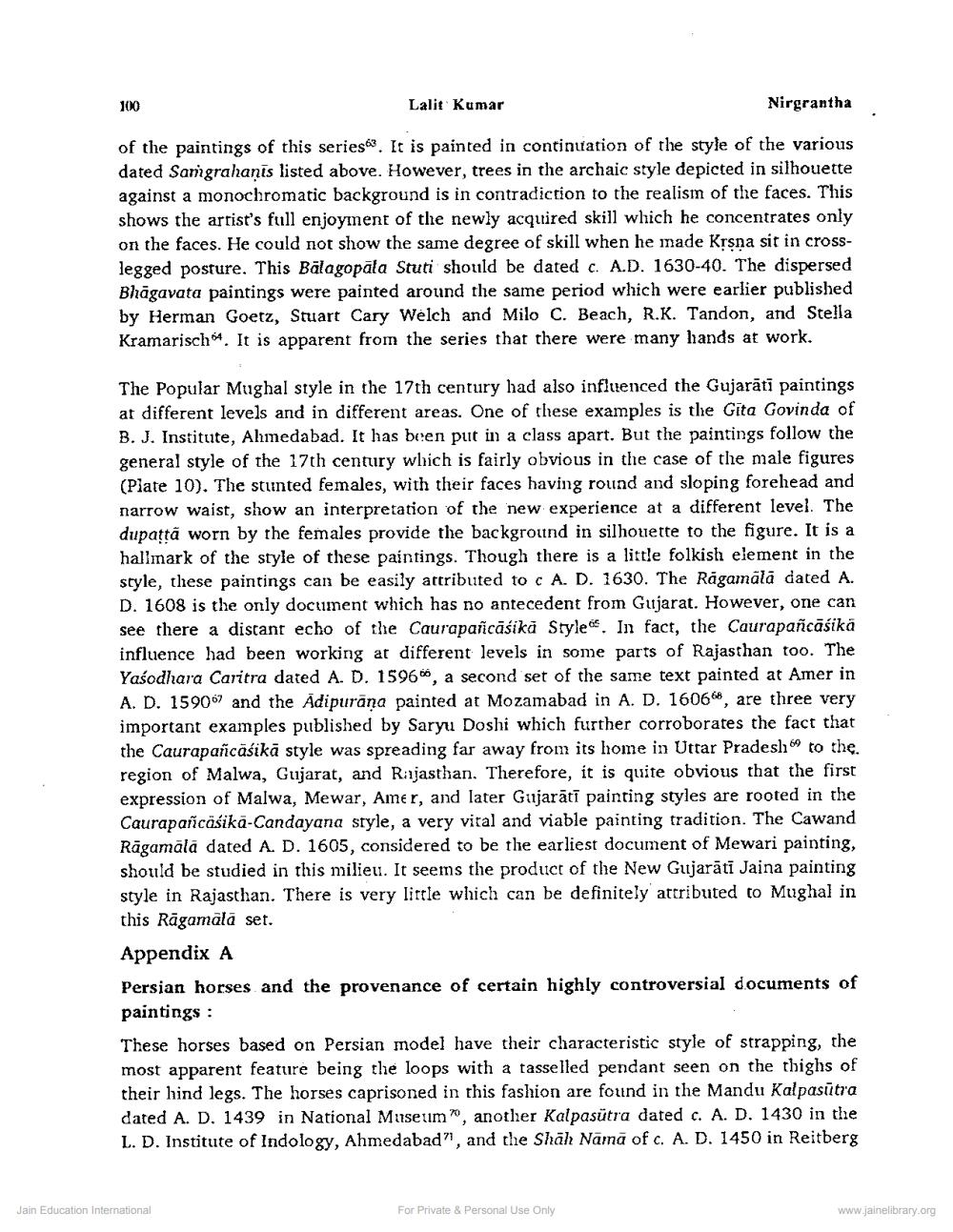Book Title: Gujarati Painting of 16th 17th Century Author(s): Lalit Kumar Publisher: Z_Nirgrantha_1_022701.pdf and Nirgrantha_2_022702.pdf and Nirgrantha_3_022703.pdf View full book textPage 9
________________ 100 Lalit Kumar Nirgrantha of the paintings of this series. It is painted in continuation of the style of the various dated Sanigrahaņis listed above. However, trees in the archaic style depicted in silhouette against a monochromatic background is in contradiction to the realism of the faces. This shows the artist's full enjoyment of the newly acquired skill which he concentrates only on the faces. He could not show the same degree of skill when he made Krsna sit in crosslegged posture. This Balagopāla Stuti should be dated c. A.D. 1630-40. The dispersed Bhāgavata paintings were painted around the same period which were earlier published by Herman Goetz, Stuart Cary Welch and Milo C. Beach, R.K. Tandon, and Stella Kramarisch64. It is apparent from the series that there were many hands at work. The Popular Mughal style in the 17th century had also influenced the Gujarāti paintings at different levels and in different areas. One of these examples is the Gita Govinda of B. J. Institute, Ahmedabad. It has been put in a class apart. But the paintings follow the general style of the 17th century which is fairly obvious in the case of the male figures (Plate 10). The stunted females, with their faces having round and sloping forehead and narrow waist, show an interpretation of the new experience at a different level. The dupatta worn by the females provide the background in silhouette to the figure. It is a hallmark of the style of these paintings. Though there is a little folkish element in the style, these paintings can be easily attributed to c A. D. 1630. The Ragamäla dated A. D. 1608 is the only document which has no antecedent from Gujarat. However, one can see there a distant echo of the Caurapascāśikā Style In fact, the Caurapañcāśikä influence had been working at different levels in some parts of Rajasthan too. The Yaśodhara Caritra dated A. D. 1596, a second set of the same text painted at Amer in A. D. 159007 and the Adipurana painted at Mozamabad in A. D. 160666, are three very important examples published by Saryu Doshi which further corroborates the fact that the Caurapañcāśikā style was spreading far away from its home in Uttar Pradesh to the. region of Malwa, Gujarat, and Rajasthan. Therefore, it is quite obvious that the first expression of Malwa, Mewar, Amer, and later Gujarātī painting styles are rooted in the Caurapañcaśika-Candayana style, a very viral and viable painting tradition. The Cawand Rāgamālā dated A. D. 1605, considered to be the earliest document of Mewari painting, should be studied in this milieu. It seems the product of the New Gujarāti Jaina painting style in Rajasthan. There is very little which can be definitely attributed to Mughal in this Rāgamalá set. Appendix A Persian horses and the provenance of certain highly controversial documents of paintings : These horses based on Persian model have their characteristic style of strapping, the most apparent feature being the loops with a tasselled pendant seen on the thighs of their hind legs. The horses caprisoned in this fashion are found in the Mandu Kalpasūtra dated A. D. 1439 in National Museum , another Kalpasutra dated c. A. D. 1430 in the L. D. Institute of Indology, Ahmedabad", and the Shāh Namā of c. A. D. 1450 in Reitberg Jain Education International For Private & Personal Use Only www.jainelibrary.orgPage Navigation
1 ... 7 8 9 10 11 12 13 14 15 16 17 18
